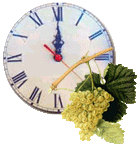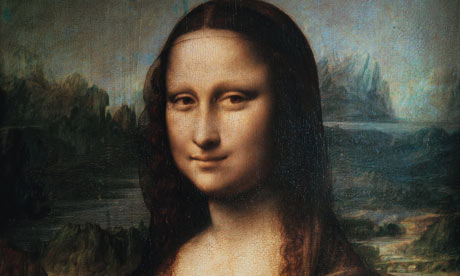The following article by Tom Kington was published on the
Guardian last Sunday 12th December.
An Italian researcher, Silvano Vinceti, has sparked new controversy over the world's most famous painting by claiming Leonardo da Vinci painted tiny letters into the eyes of the Mona Lisa which may finally reveal the disputed identity of his model.
To arrive at a theory worthy of The Da Vinci Code, Dan Brown's 2003 bestseller, researcher Silvano Vinceti avoided the Mona Lisa's enigmatic smile and instead gazed deep into her eyes with the help of high-resolution images.
"Invisible to the naked eye and painted in black on green-brown are the letters LV in her right pupil, obviously Leonardo's initials, but it is what is in her left pupil that is far more interesting," said Vinceti, the chairman of the Italian national committee for cultural heritage.
Vinceti said that the letters B or S, or possibly the initials CE, were discernible, a vital clue to identifying the model who sat for the Renaissance artist. She has often been named as Lisa Gherardini, the wife of a Florentine merchant, but Vinceti disagreed, claiming Leonardo painted the Mona Lisa in Milan. He said he would announce his conclusions next month.
"On the back of the painting are the numbers '149', with a fourth number erased, suggesting he painted it when he was in Milan in the 1490s, using as a model a woman from the court of Ludovico Sforza, the Duke of Milan," said Vinceti, who claimed earlier this year that he had identified the lost remains of the painter Michelangelo da Caravaggio.
In The Da Vinci Code, Brown suggests Mona Lisa is an anagram for Amon l'Isa, referring to ancient Egyptian deities.
"Leonardo was keen on symbols and codes to get messages across, and he wanted us to know the identity of the model using the eyes, which he believed were the door to the soul and a means for communication," said Vinceti.
He said that while researching the model's identity he had been inspired by a 1960s book by a French art historian, which mentions the letters in her eyes.
"Under the right-hand arch of the bridge seen in the background, Leonardo also painted 72, or L2, another possible clue," he added. "Two expert painters we consulted on this tell us that all these marks, painted using a tiny brush and a magnifying glass, cannot be an error."
The eyes have it. Everything you need to know… or at least the clues. And the world famous Mona Lisa is no different. Good Morning America uncovers her hidden symbols.
REPORTER: “In the right eye, he claims, are the letters ‘LV’ – Leonardo da Vinci, the man who painted her 500 years ago. And in the left eye, symbols, but they’re not as defined. ‘C’ ‘E’, maybe ‘B?’ In the bridge, is that ‘72?’”
WHAT DOES IT ALL MEEEEAN?? We have four answers. First, Lalate says the letters in the left eye reveal the real life Mona. That’s if you believe researcher Silvano Vinceti: “Previous researchers had said Lisa Gherardini was the model. Vinceti disagrees, says he has determined the model’s identity, and claims his findings will be released in January.”
Not so! Just ask Regis and Kelly…and ABC World News Now. Hmph…maybe not the most informed opinions of all time…
LIVE! with Regis & Kelly
PHILBIN: “In the right eye, appears to be the letters ‘LV,’ which could well stand for his name.”
RIPA: “Louis Vuitton?”
PHILBIN: “’C’ and ‘E’ or ‘B.’”
RIPA: “Or it could be two ‘G’s for Gucci.”
ABC MALE ANCHOR: (Photo of ABC News logos in eyes) “We took a closer look and we actually found something a little different. That’s what it says (She’s our mascot). Who knew years ago that da Vinci would be creating this for us?”
FEMALE ANCHOR: “Well, she’s often to referred to as the world’s most beautiful woman, so it’s only fitting she has the world’s most beautiful show in her eyes.”
Finally, an art historian on CNN argues it might just be a weird code. He says da Vinci did lots of strange stuff like carry around the painting for years, so no one could touch it: “That’s not only crazy. That’s amazing to me. I love when I hear something like that. As far as why he did those things—I think when you’re that kind of brain faced with all the other normal brains like the rest of us around him, maybe you just get bored…maybe you are writing a secret message.”
Up next for the researchers….they want to dig up da Vinci’s 500-year-old body to see if his face resembled the Mona Lisa’s. Art history never sleeps, ladies and gentlemen…
Writer: Chance Seales
No copyright infringement intended. For educational, non-commercial purposes only.


































